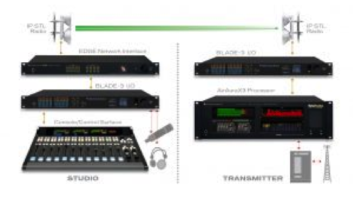Prior Coordination for STLs
May 1, 2012 1:00 AM, By Jeremy Ruck, PE
Let’s face the fact that broadcast auxiliary facilities are somewhat less than glamorous. These quiet, unassuming workhouses of the program stream tend in many facilities to be housed in a sketchy rack in a dark back closet or furnace room of an otherwise slick and beautiful facility. No doubt, they are aware of this relegation to second-class citizen for functionality issues tend to pop up at inopportune times. While we cannot totally eliminate equipment failures, due diligence in the realm of coordination and licensing can go a long way towards reducing other types of “gotchas.”

It was not that many years ago that the Federal Communications Commission revised the broadcast auxiliary coordination requirements to put some more teeth into them. Before those procedural changes, applications were routinely filed without undergoing any formal coordination. Since there tends to be courtesy among broadcasters, incidents of problems tended to be rare. The increase in the number of broadcast facilities and consolidation in the marketplace has made the coordination process essential, the Commission’s rules notwithstanding.
Finding space
Every new station that goes online can require up to 500kHz of spectrum in a band only 8MHz wide. In cases where multiple paths are required, the amount of spectral real estate carved up tends to double. Combine this with consolidation situations where several stations are programmed out of a single building, and the available auxiliary spectrum is indeed scarce. These situations do not even address the desired use of the auxiliary spectrum by licensees of translators. The popularity of translators for AM fill-in use has definitely increased spectrum demand. It should be noted, however, that auxiliary facilities providing program material to translators may not interfere with or preclude full-power STL uses.
No doubt, you have received several, if not many, frequency coordination notices. These notices form one side of the coordination process. The notifications must include the relevant technical details of the proposed facility. In essence, the proponent must provide sufficient technical details so that an independent analysis of the proposed path can be made before the facility application is submitted. Although the actual format of these notices will vary subtly, most firms will include an introduction letter, tabulation of technical details, and graphical illustration of the proposed path.
From these details, a qualitative analysis can usually be made fairly simply. For instance, if the proposed path is 100 miles away from yours, cross-polarized and operating in the opposite direction, it is a good bet that it will not cause you problems. On the other hand, a proposed path in the same market as yours that is very close in frequency could prove problematic. Thus, any coordination notice received should definitely be considered carefully.
– continued on page 2
Prior Coordination for STLs
May 1, 2012 1:00 AM, By Jeremy Ruck, PE
If the proposed path looks to be potentially problematic at face value, a more in depth quantitative analysis is warranted. Several different methodologies for quantitatively analyzing a path are available including TIE-EIA Bulletin TSB10-F among others. These standards are usually not in the library of a station due to their cost, so a call to your consulting engineer may be the most efficient way to address the concern. In reality, a once-over by your consulting engineer is a cheap insurance policy against loss of financial income by the station, and political capital by you.
If there are no issues with the path, then the response phase of the coordination process kicks in. Under this phase, a response is made to proposal provided by the proponent. The Commission’s Rules state if no response has been received after 30 days following receipt of the proposal, then the proponent can be assumed to have made a reasonable effort to coordinate the proposed facilities. This provision is what most firms utilize in coordination requests, and why many request letters will advise no response is necessary if there are no objections to the proposed path.
When time matters
Although the 30-day period is the norm, the Commission’s Rules do provide for expedited coordination under shorter time periods. Expedited coordination may be employed if deemed necessary by the notifying party; however, the Commission does not provide guidelines on what are the criteria for expedited coordination. What the Commission does, however, state is that the notifying party is responsible for receiving written concurrence with the proposal if expedited coordination procedures are followed. In other words, it is not acceptable, although frequently done, to request an expedited coordination window, advise that no response is necessary to the proposal, and assume coordination is complete in two weeks time.
Once the responses are received, or the necessary time has elapsed as the case may be, the coordination process can be assumed to be complete. At this point, the application, if for new or major changes, can be filed. Certification that frequency coordination has been completed must be submitted in order to obtain a grant of the license. The certification of coordination is an exhibit that spells out the procedures utilized, and lists the entities with which contact was made regarding the proposed link.
Any negative response to a proposed facility in essence stops the clock. Before coordination can be assumed to be complete, these issues must be mutually worked out between the affected parties. Sometimes these issues are fairly simple in nature. For instance, some time ago we received an objection to a proposed path due to a significant increase in interference. The apparent substantial increase in interference resulted from an incorrect receiver parameter. Following a friendly discussion, the objection was withdrawn, and coordination completed. In this instance, no change to the proposed facility was made, so no additional notifications were required. In other cases where changes must be made, subsequent notices must be provided. The clock has to be watched here as well, as the coordination request sunsets if no application is filed within six months of the date of coordination initiation.
The coordination process is essentially required anytime an application is filed. Since the threshold for what is considered a major change under the wireless radio services is quite low, figure on going through the coordination process anytime you file an application. Although initially the process was seen as an added burden, the reality is the imposition of the process on broadcasters has tended to mitigate problems for a number of years now.
Ruck is a senior engineer with D.L. Markley and Associates, Peoria, IL.
May 2012
Inside Dial Global’s radio network, audio production from the field, prior coordination for STLs, a Field Report on the IsoAcoustics ISO-L8R and budget mics for remotes….








